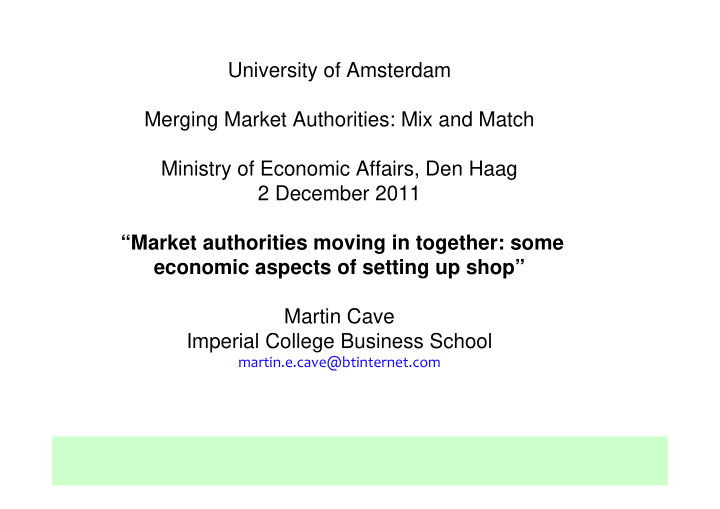



University of Amsterdam Merging Market Authorities: Mix and Match Ministry of Economic Affairs, Den Haag 2 December 2011 “Market authorities moving in together: some economic aspects of setting up shop” Martin Cave Imperial College Business School martin.e.cave@btinternet.com
Public interest objectives of institutional design of regulatory agencies Process - Fairness - Independence Outcome - Control costs - Maximise social welfare from interventions With no linkage between interventions, cost minimisation is the chief goal, but … London School of Economics Mec1833 2
In fact there is competition in the supply of interventions: this ‘market’ has to be appropriately structured. There is some convergence between ‘pre-emptive competition law’ and ‘regulatory anti-trust.’ But which is used does matter; there are significant differences between: - objectives: consumer welfare for competition authority vs. consumer welfare and profits for sector regulator - ex ante and ex post processes - essential facilities & mandated access - competition law and regulatory definitions of margin squeezes - appeal mechanisms - etc, etc. London School of Economics Mec1833 3
The balance between ex ante and ex post “ As a general matter, regulated dominant firms in Europe have often been unduly shielded from the disciplines of both competition and competition law, while at the same time being over-regulated. The application of competition law, although far from perfect, is less prone than regulation to sector-specific capture (whether by vested or political interests), is not monopolised by the regulator, and can facilitate desirable deregulation. ” J Vickers, ‘Competition Policy and Property Rights’. Economic Journal, 2010 London School of Economics Mec1833 4
To manage the process we need to understand what it is that bureaux maximise? The public interest alone? Or, additionally, private interests: - the bureau’s size/budget? - its influence? - its discretion? There will be incentives to hoard issues, pre- empt decisions, prevent mergers (poison pills) etc. Where private interests are recognised, institutional design should take account of them. London School of Economics Mec1833 5
The design options to be considered Horizontal options - unitary structure of competition/ economic regulation (ACCC, Netherlands post merger) - separate regulators (most commonly observed) - concurrency/shared (different models: division of labour – may be close to unitary model; or embody a veto from either party) Plus a range of vertical options, such as unification or separation of Phases1 and 2 in UK merger cases London School of Economics Mec1833 6
Separate(S) vs Unitary (U): pros and cons I Firm opportunism: especially via forum shopping. If it applies, it favours U Agency opportunism: regulator chooses easiest, not most appropriate route (usually a sector- specific one). Favours S Additionally, agency maximises activity, ‘keeps the work to itself’. May favour S Regulatory capture: harder to suborn two agencies. Favours S Expertise: separated competition authority lacks expertise to cope with complex network industry cases. Favours U, if it applies. London School of Economics Mec1833 7
Separate (S) vs Unitary (U): pros and cons II “Double jeopardy”: Can improve outcome – eg DT margin squeeze case, where competition authority impugns tariffs approved by the regulator; note also UK water case. Favours S? Need for multiple viewpoints: ‘why is there only one monopolies commission?’ Favours S Will sector-specific activity overwhelm competition law in a unitary system? Has not done so in Australia Cost savings: can be important in small country. Favours U, but how material? London School of Economics Mec1833 8
Is concurrency the solution? In the UK, concurrency means that the sectoral regulator takes the leading role in applying competition law. This is close to a unitary system in specific network industries Regulators in the UK with competition powers have been criticised for favouring easier regulatory interventions over more radical competition law ones, eg including divestment Alternatively, concurrency can mean the need for agreement by agencies rather than competition between them. See analysis by Barros & Hoernig, CEPR 2004 London School of Economics Mec1833 9
My (debatable) overall evaluation Decision must take account of likely agency objectives, including dysfunctional ones Cost savings likely to be small in relation to benefits of better interventions Desirable to build in a bias in favour of deregulation Two independent agency voices are better than a monopoly opinion Hence a tentative preference for separation Parenthetically, in communications, a unitary telecommunications, broadcasting , spectrum agency is highly desirable. London School of Economics Mec1833 10
Recommend
More recommend